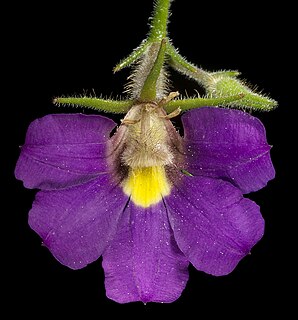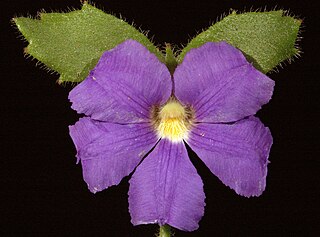
Scaevola is a genus of flowering plants in the Goodenia family, Goodeniaceae. It consists of more than 130 tropical species, with the center of diversity being Australia and Polynesia. There are around 80 species in Australia, occurring throughout the continent. Diversity is highest in the South West, where ca. 40 species are endemic.

Scaevola aemula, the fairy fan-flower or common fan-flower, is a small shrub in the family Goodeniaceae, native to southern Australia. It grows to 50 cm in height and produces white or blue flowers in spikes up to 24 cm long from August to March in its native range. These are followed by rounded, wrinkled berries to 4.5 mm in length.

Duranta erecta is a species of flowering shrub in the verbena family Verbenaceae, native from Mexico to South America and the Caribbean. It is widely cultivated as an ornamental plant in tropical and subtropical gardens throughout the world, and has become naturalized in many places. It is considered an invasive species in Australia, China, South Africa and on several Pacific Islands. Common names include golden dewdrop, pigeon berry, and skyflower. In Mexico, the native Nahuatl name for the plant is xcambocoché. In Tonga it is known as mavaetangi.

Scaevola hookeri, the creeping fan-flower or alpine fan-flower, is a prostrate perennial herb in the family Goodeniaceae. It is native to eastern Australia. Leaves are 6 to 50 mm long and 2 to 15 mm wide. Flowers are white or blue with a yellowish throat and appear between December and March in the species' native range. The species was first formally described by W.H. de Vriese in 1850 in Nederlandsch Kruidkundig Archief and given the name Merkusia hookeri. The species was transferred to the genus Scaevola in 1856. It occurs in grassland and woodland in high altitude areas in Victoria, New South Wales, Tasmania, and also South Australia where it is listed as "endangered".

Coopernookia is a plant genus of six species of small perennial shrubs that are all endemic to Australia. They have hairy, often sticky leaves, and flowers with bilateral symmetry.

Scaevola calendulacea known as the dune fan-flower, is a small shrub found on sand dunes in eastern and southern Australia.

Scaevola canescens is a species of plant in the family Goodeniaceae. It is endemic to Western Australia where it occurs "from Shark Bay to Perth, in open forest and heath in sandy soil".

Scaevola argentea, is a low growing, branching shrub in the Goodeniaceae family.

Scaevola acacioides, is an erect, spreading shrub in the Goodeniaceae family.

Scaevola basedowii is an erect multi-stemmed shrub in the Goodeniaceae family, endemic to Western Australia, the Northern Territory and South Australia.

Scaevola browniana is a shrub in the Goodeniaceae family, endemic to Western Australia, the Northern Territory and Queensland.

Scaevola glandulifera, the viscid hand-flower, is a shrub in the family Goodeniaceae, endemic to Western Australia.

Scaevola plumieri is a species of plant in the Goodeniaceae family which grows on coastal dunes in the tropics and subtropics.

Scaevola amblyanthera is a small shrub in the Goodeniaceae family which is found in tropical and central Australia.

Scaevola collaris is a shrub in the family Goodeniaceae and its native range is five mainland states/territories of Australia: the Northern Territory, New South Wales, South Australia, Queensland and Western Australia.

Scaevola nitida is an erect shrub in the Goodeniaceae family, native to Western Australia. It grows to a height of 0.3 to 3 m, and its blue-purple flowers may be seen from August to December.

Scaevola humifusa is a prostrate shrub in the Goodeniaceae family, native to Western Australia. It grows to a height of 0.01 to 0.5 m, and its white-cream/white-blue flowers may be seen from August to November or January.

Scaevola parvifolia is an erect, many stemmed perennial in the Goodeniaceae family, which is native to Western Australia, the Northern Territory, Queensland and South Australia. It grows to a height of 0.6 m, and its blue-purple flowers may be seen from March to October.

Scaevola phlebopetala, commonly known as velvet fanflower, is a herb in the Goodeniaceae family and is endemic to Western Australia.

Scaevola pilosa, commonly known as the hairy fan-flower, is a perennial herb in the family Goodeniaceae. It is endemic to the south-west of Western Australia.
.





















